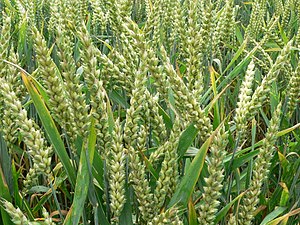By chance I caught this audio segment from CBC Radio‘s The Current. Dr. William Davis, a cardiologist from Wisconsin postulates that the wheat grain used in agriculture today is very different from the wheat grain grown from fifty years ago. As a result of this difference, he believes (aside from the increase in sedentary lifestyles) that the consumption of this grain is actually addictive which not only leads to overeating but also to an increase in the “accumulation of deep visceral fat – that is fat that accumulates around the organs but is shown on the surface as a large belly…It is this visceral fat that is different – it is unique, metabolically different from the other fat, say, found on your back side or arm or leg – it is metabolically active, it produces inflammatory proteins, it causes diabetes, hypertension etc.”
He calls this large belly a Wheat Belly, which is also the title of his book. You might imagine the controversy his theory is generating among grain farmers and others. Of course, I find this most fascinating especially if you consider my latest post titled, Full But Empty?
He briefly talks about the fact that in an effort to be healthy we are encouraged to eat more whole grains or complex carbohydrates most often in the form of whole wheat…’because complex carbohydrates sounds healthier versus simple sugars,’ but in fact they (the whole wheat grain) may very well be the source of the problem. He comments on how people or his patients who complain that since they’ve been eating ‘apparently healthier’ or exercising more they have strangely put on more weight and can’t seem to shake it.
Something we need to address is: what is a complex carbohydrate in the first place? Do you know? The first item that comes to mind for most people is GRAINS. But in fact, complex carbohydrates abound. Here is a list from Livestrong.com of some, not all complex carbohydrates:
“GRAINS millet, oats, wheat germ, barley, wild rice, brown rice, buckwheat, oat bran, cornmeal and amaranth.
FRUIT apricots, oranges, plums, pears, grapefruits and prunes.
VEGETABLES Broccoli, cauliflower, spinach, turnip greens, eggplant, potatoes, yams, corn, carrots, onions, all types of lettuce, celery, cucumbers, cabbage, artichokes and aspragus
Soy milk made from soy beans is a complex carb and dairy products like low-fat yogurt and skim milk are also complex carbs.”
As you can see, complex carbohydrates are in abundance, we are not at a loss if we should eliminate wheat as an experiment. In fact if you do, you may find that you end up eating more vegetables which is a better choice regardless.
Here is the link for the audio segment from CBC Radio’s, The Current featuring Dr. William Davis. It is 24 minutes long. When you open the link, just below the title/ opening paragraph you will see a black bar which reads- Listen: (Pop-up). Turn up your volume.
Maybe whole grain wheat could be utilized for other things such as cleaning products? It must be useful for something other than food. I would LOVE to hear any comments or stories that are relevant to to this topic…please share your ideas below.
Related Articles:
